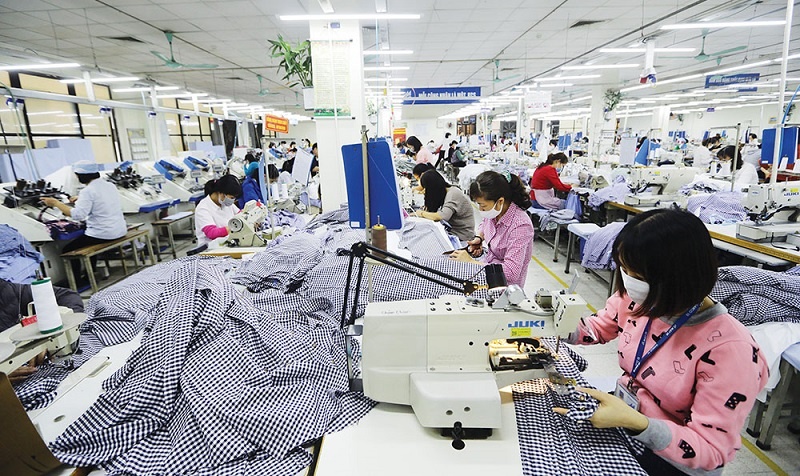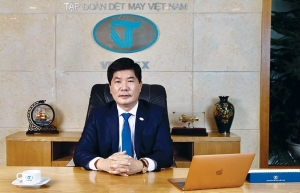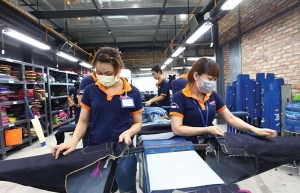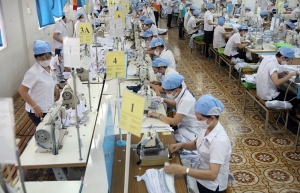Textile and apparel firms increasingly going green
According to the Vietnam Textile and Apparel Association (Vitas), greening the textile and apparel sector has become a global trend that local firms must follow to reach sustainable development targets and scale up export into key markets like the EU and United States.
It would be particularly significant as new-generation free trade agreements with Vietnam’s engagement all feature the commitments for environmental protection and emission reduction, Vitas stated.
This would require firms to invest in cutting-edge production technology which also entails mounting challenges.
“Funding is a big issue, particularly as 90-95 per cent of units in the textile and apparel sector are of small and medium size,” said Truong Van Cam, Vitas’ deputy chairman.
 |
Currently, most firms in the textile and apparel supply chain performing export processing for global brands have been mandated to satisfy set requirements on environmental, social, and emission reduction standards, among others.
Based on their scale, capacity, and customer requirements, each firm works on suitable plans to meet the criteria.
With export scale surpassing $3.5 billion a year, the state-owned textile and apparel conglomerate Vinatex unveiled that in the immediate future the company will be investing in novel technologies to reduce 30 per cent of wastewater after dyeing, reusing 30 per cent of this wastewater after being treated to diverse stages of washing and cleaning.
| To join the global game, Vietnamese firms need to become more transparent in production, ensure their products have a clear origin and meet green production standards, and increase the volume of products that can be recycled. |
In addition, Vinatex also commits to installing solar panels for its factories with suitable natural conditions to reach the target of having 10 per cent of its power come from renewable energy sources.
Tran Nhu Tung, deputy general director at Thanh Cong Textile Garment Investment Trading JSC, and head of the Sustainable Development Department at Vitas, assumed that practising sustainable development standards might bring difficulties to businesses in the initial period, but in the long haul, it would help firms to bolster reputation and brand and sharpen competitiveness against their rivals from other countries.
A recent survey from US Cotton Trust Protocol shows that about 70 per cent of brands and retailers are paying more attention to the environmental impacts of fashion products.
Many leading fashion brands have announced just supplying products made from sustainable material sources.
For instance, Europe’s fashion brand H&M commits to promoting carbon-neutral supply chain development for its production factories through signing contracts with its sub-contractors, aiming at reaching the target of using only raw material from recycling sources by 2030.
 | Creating more solidarity to accomplish Vinatex goals Vietnam’s garment and textile exports were estimated to have hit $39 billion last year, representing an increase of 11.2 per cent on-year and 0.3 per cent higher than the figure in 2019, before strict pandemic restrictions were imposed. This success was attributed partly to Vietnam’s state-run Vinatex and its subsidiaries, which all expect further impressive growth this year. |
 | Textilers adhering to strict measures Despite positive results in the first half of 2021, textile and garment businesses are facing enormous challenges to maintain their manufacturing activities during a social distancing period in the south. |
 | Textile and apparel sector yearning for government support to curtail COVID-19 impacts Textile and apparel businesses in South Vietnam are facing critical levels of disruption due to severe social distancing measures to combat the COVID-19 pandemic and are requesting urgent support from the government and other industries to reboot operations. |
This means more than 30 per cent of H&M suppliers in Vietnam must come on par with the standards on sustainable material usage.
To join the global game, Vietnamese firms need to become more transparent in production, ensure their products have a clear origin and meet green production standards, and increase the volume of products that can be recycled.
According to Dao Thanh Tung, director of IDFL Vietnam, an accredited certifying body for major textile standards, as consumers both locally and globally are increasingly stringent about quality standards, including the origin of raw materials and the whole production process, Vietnamese firms need to take on changes and compliance to fully meet requirements from both importers and the brands themselves.
What the stars mean:
★ Poor ★ ★ Promising ★★★ Good ★★★★ Very good ★★★★★ Exceptional
Related Contents
Latest News
More News
- Vietnam striving to ease air pollution (January 09, 2026 | 14:41)
- Petrovietnam Gas awards first multi‑year LNG deal to Shell (January 09, 2026 | 14:38)
- Advancing the net-zero journey: Carlsberg Vietnam’s sustainability progress in 2025 (January 09, 2026 | 09:49)
- The green hydrogen and ammonia future for Vietnam (January 06, 2026 | 15:03)
- Green transition to close $20 billion annual investment gap (December 31, 2025 | 11:59)
- Australia contributing to Vietnam’s climate change responses (December 30, 2025 | 11:37)
- CME Solar strengthens position in Vietnamese renewables (December 30, 2025 | 11:21)
- Self-care signals shift towards sustainable healthcare (December 30, 2025 | 10:12)
- GreenYellow marks five years of clean energy growth in Vietnam (December 26, 2025 | 15:51)
- TCP Group partner with VNUS to launch water conservation project (December 25, 2025 | 14:00)

 Tag:
Tag:

























 Mobile Version
Mobile Version